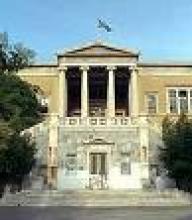January 12, 1837 (December 31, 1836, old style) has been founded in Athens by Royal Decree a Sunday training school for technicians.
Indeed, in 1837, a young Bavarian, the officer in the engineering corps Friedrich R. von Zentner, was entrusted to train on Sundays qualified workers and foremen for building. These men were needed for the transformation of Athens from a village to the capital of the new state, proud of its neo-classical buildings designed by Architects who came from abroad: the Palace, the University, the Archeological Museum, the Observatory etc.
F. R. von Zentner has been the first director of that Scholl. To organizing it he was inspired by the Royal School for Building Arts of Munich and the Technical School "La Martini" of Lyon. Until 1838, each Sunday morning, from 8 to 12, students followed curses of design and mathematics (arithmetic and geometry) and on the afternoon, from 14 to 17, fine Arts. The school was housed in a building, rented for that purpose, at Peiraios Street.
In 1840, parallel to that Sunday School, a daily school began to function and in addition, thanks to a donation by the Duchess of Plakentia, a School of Fine Arts. The program of the curses has been enriched, as lessons of architecture, industrial design, technology, orthography and calligraphy have been added.
Following the revolution of September 3, 1843, which imposed the Constitutional State, all foreigner civil servants (included Zentner) have been fired. The next director of the institution from 1843 to 1862, the architect Lysandros Kautantzoglou mainly reinforced its artistic vocation.
After the 1860’s, new technological needs emerged in the Greek state. Industry began to develop and the first urban plan was implemented in Athens in the mid 1850’s. Other Greek towns too began to receive their first public buildings and infrastructure. Greece also began to need mechanics (to repair and service steam machines for example) as well as supervisors for the developing ‘public works’ sector. To respond to these new demands, the institution was reformed in 1863, during the provisional directorship imposed after the revolution of 1862 and the departure of king Othon. It became a secondary level institution admitting only graduates from the Elliniko Scholio and was divided into two different Daily Schools each with a unique program: the School of Fine Arts with a five year duration and the School of Industrial Arts with a three year cursus.
During the next period and during the directorship of Demetrius Scalistiris (1864-1873), a military man who studied at the Ecole Polytechnique in Paris, standards at the School of Industrial Arts improved tremendously. A decade later, this School would acquire a new structure when it was divided into three sections: Architecture (which trained civil engineers, duration 4 years), Surveying (also 4 years) and Mechanical Engineering (5 years). It should be noted that in 1873 the school was renamed Metsovio Polytechnio after the small town of Metsovo in northern Greece. Men from that town belonged to the Greek Diaspora (in this case Egypt), and they donated large sums of money to the school. Due to important donations by Nicolaos Stournaris, Michael Tositsas and George Averof, new buildings have been constructed (from 1862) to house the Metsovio Polytechnio.
In 1887, during the Tricoupis period (1880-1895) when Greece was marked by an unprecedented program of public works, the Metsovio Polytechnio was once again reorganised by the military man Anastasios Theophilas, a former student of the French Ecole de Saint-Cyr, and who was named director of the school from 1887-1901. The Metsovio Polytechnio became a tertiary level institution accepting only students with a certificate of secondary level education. Differential and integral calculus were taught and after a 4 years cursus the School awarded a degree in Civil or Mechanical Engineering.
The turn of the century would bring more change. Civilians replaced military personnel in the administration of the school. The professors, the vast majority of whom had till then received their education in the French "Grandes Écoles", began to be trained in Germany. From 1910, Fine Arts and Industrial Arts were administratively divided. Fine Arts vacated the building of Metsovio Polytechnio and became an independent institution. Decree 338/1914 implemented by Agelos Ginis (director of the Metsovio Polytechnio from 1910 to 1916), an engineer trained at Karlsruhe, gave the institution a university statute. Finally, decree 980/1917 gave it almost its present form by establishing a 5-year course in each one of the following 5 Departments: Architecture, Civil Engineering, Mechanical and Electrical Engineering, Chemical Engineering and Topographical Engineering (Surveying).
For up to date information on the National Technical University of Athens, please consult its web site.





















